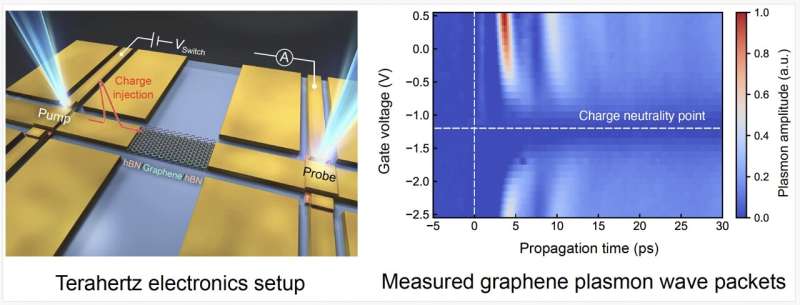August 8, 2024 feature
This article has been reviewed according to Science X's editorial process and policies. Editors have highlighted the following attributes while ensuring the content's credibility:
fact-checked
peer-reviewed publication
trusted source
proofread
Generating and detecting graphene plasmon polaritons with terahertz electronics

Graphene plasmon polaritons are a class of hybrid quasi-particles with advantageous optoelectronic properties. These particles have proved promising for the development of miniaturized nanoscale circuits that operate in the terahertz and mid-infrared regions of the electromagnetic spectrum.
These terahertz circuits could potentially process information at remarkable speeds, thus contributing to the further advancement of electronics. Despite the potential of graphene plasmon polaritons for realizing nanoscale terahertz circuits, existing techniques have proved ineffective in integrating the electronic components necessary to control polariton signals.
Researchers at NTT Basic Research Laboratories and various institutes in Japan recently devised a strategy to reliably generate, manipulate and detect graphene plasmon wave packets on-chip using terahertz electronics. Their proposed strategy, presented in a paper published in Nature Electronics, opens new possibilities for the development of graphene plasmonic integrated circuits.
"Our research was driven by the goal of developing ultrafast integrated circuits using graphene plasmon, which possesses unique properties such as tunability, low loss, and tight confinement of terahertz electric fields—attributes challenging to achieve with conventional electronics," Katsumasa Yoshioka, co-author of the paper, told Tech Xplore.
"Our project was the product of a collaborative effort, bringing together experts in electrical transport measurements and ultrafast laser spectroscopy. This interdisciplinary approach fostered a rich exchange of ideas and expertise, leading us to our breakthrough findings."
Conventional methods to generate terahertz graphene plasmons rely on optical excitations, thus their efficiency is significantly limited by a mismatch between the momentum of photons and the plasmons.
The new approach introduced by Yoshioka and his colleagues overcomes the limitations of these methods, by directly injecting charge pulses into graphene via ohmic contacts, which significantly enhances the generation efficiency on-chip.
"This method marks a crucial step towards building graphene plasmon circuits," Yoshioka explained. "We tackled the challenge of managing terahertz electrical signals, three orders of magnitude faster than conventional gigahertz electronics, by integrating ultrafast femtosecond laser systems with photoconductive switches, enabling us to generate and detect these signals in the time domain."
The researchers demonstrated the feasibility of their proposed strategy in a series of tests, where they injected electrical pulses into a graphene micro-ribbon via an ohmic contact. They showed that these pulses could be efficiently converted into a plasmon wave packet with short pulse durations.
"We demonstrated the ability to manipulate the phase and amplitude of terahertz electrical signals on-chip using just an external voltage applied to the gate electrode," Yoshioka said. "Remarkably, we confined the plasmon wave packets within a volume of approximately 2.1 × 10–18 m³, vastly smaller than their free-space equivalents by a factor of over 5 billion."
This recent work by Yoshioka and his colleagues could pave the way for the development of nanoscale terahertz circuits. These circuits could in turn be used to develop new electronic devices for a wide range of applications that can process data faster and more efficiently.
"Looking ahead, we plan to enhance the complexity and functionality of graphene plasmon circuits," Yoshioka added. "Our future work aims to integrate tunable filters, modulators, and amplifiers within these circuits, pushing the boundaries of what's currently possible in terahertz electronics and inspiring new directions in the field."
More information: Katsumasa Yoshioka et al, On-chip transfer of ultrashort graphene plasmon wave packets using terahertz electronics, Nature Electronics (2024). DOI: 10.1038/s41928-024-01197-x
© 2024 Science X Network




















